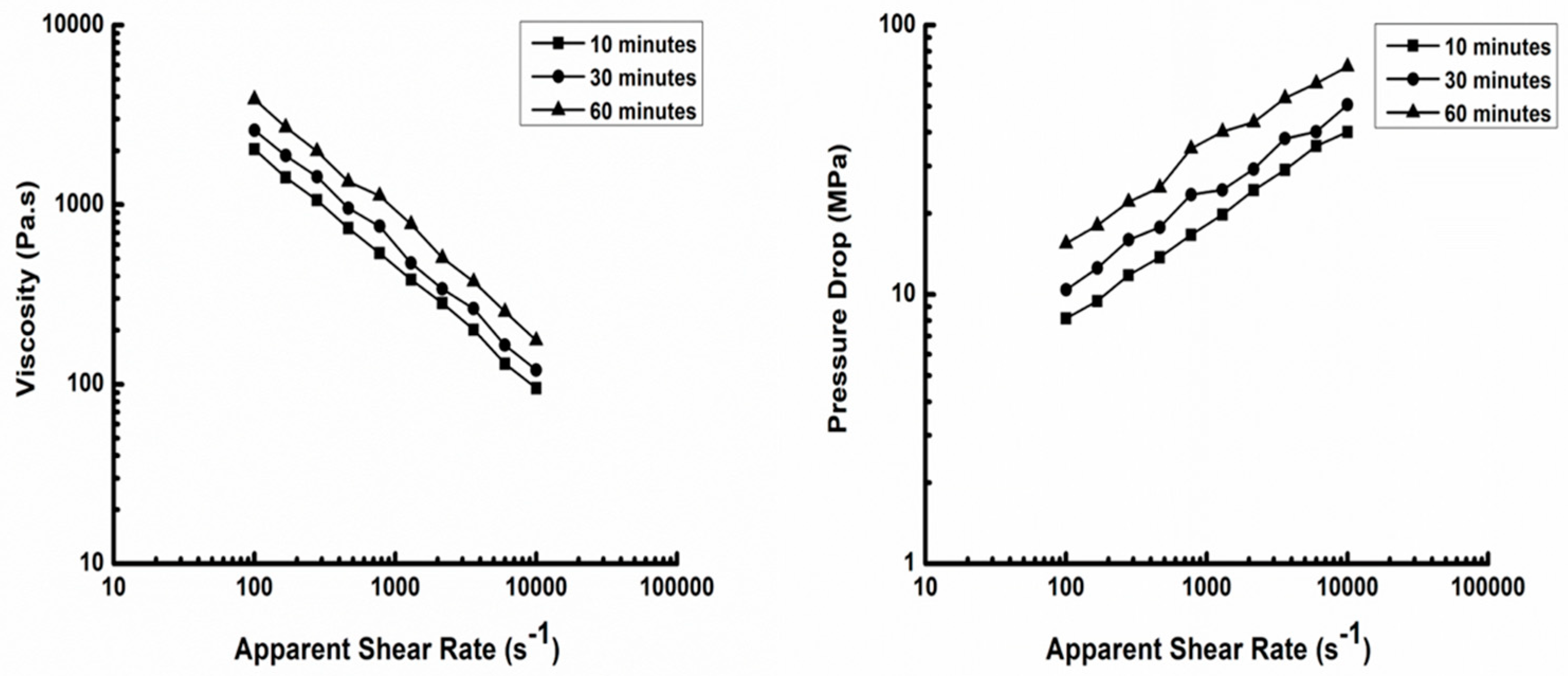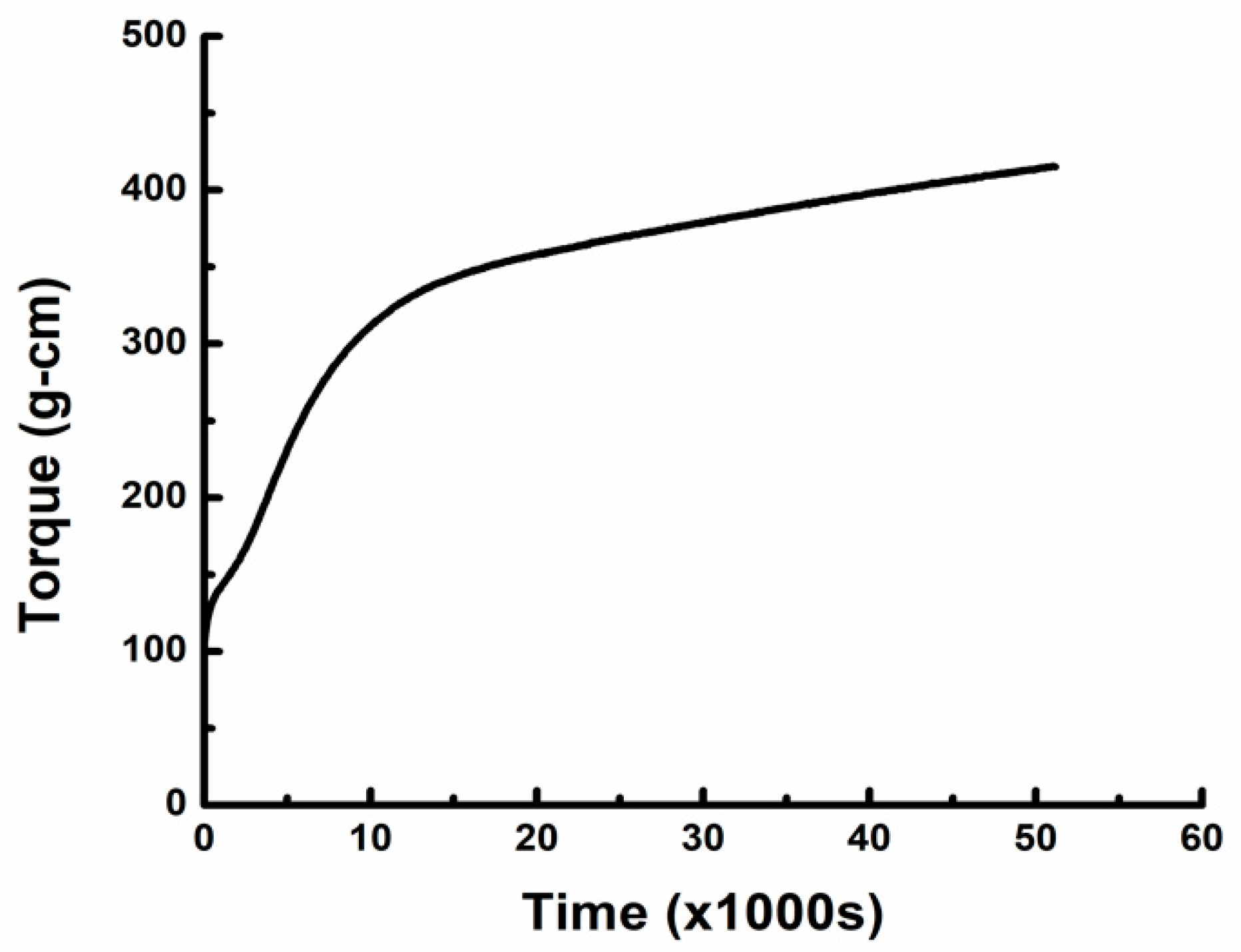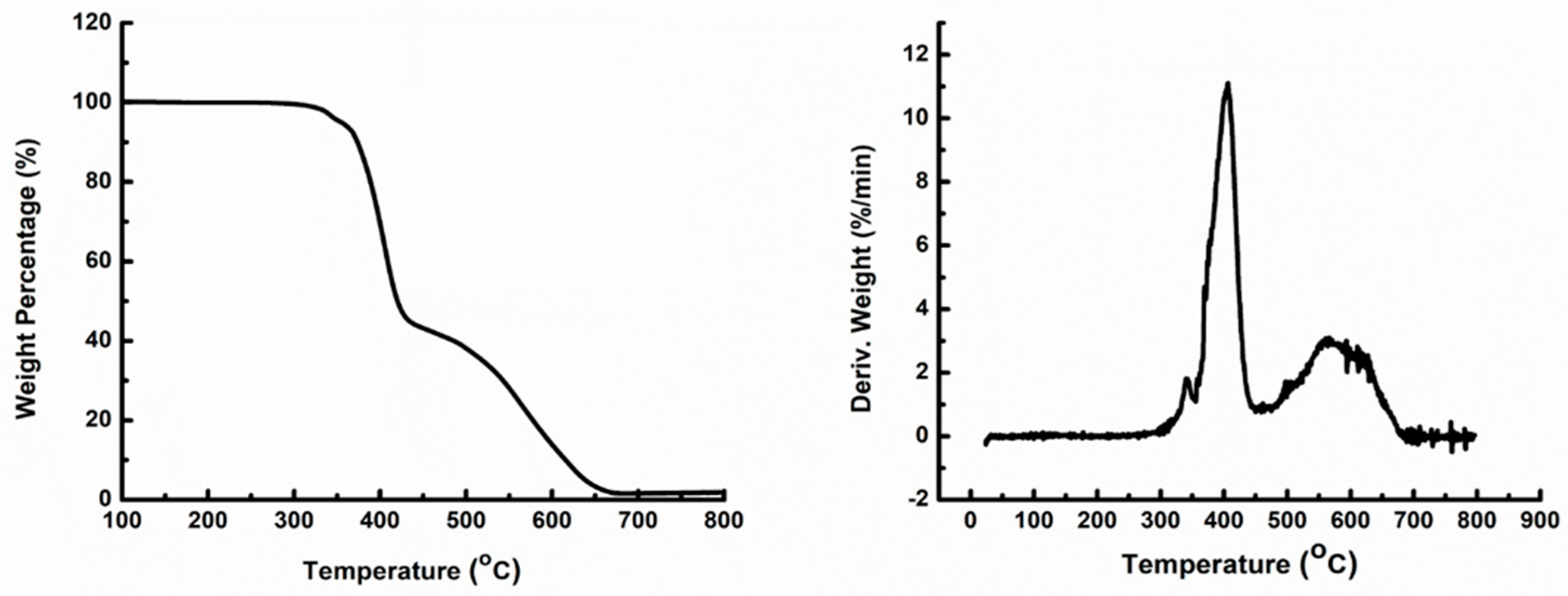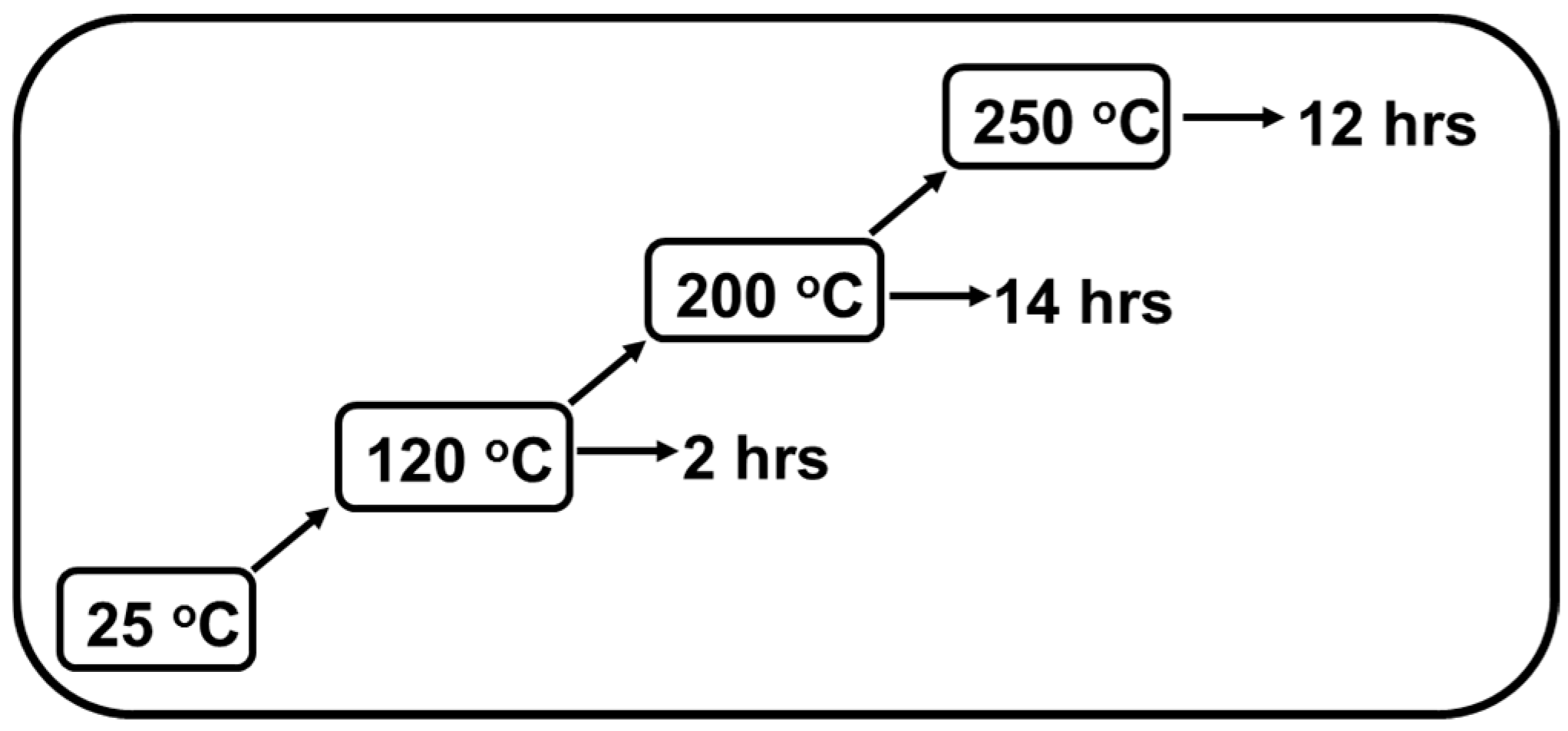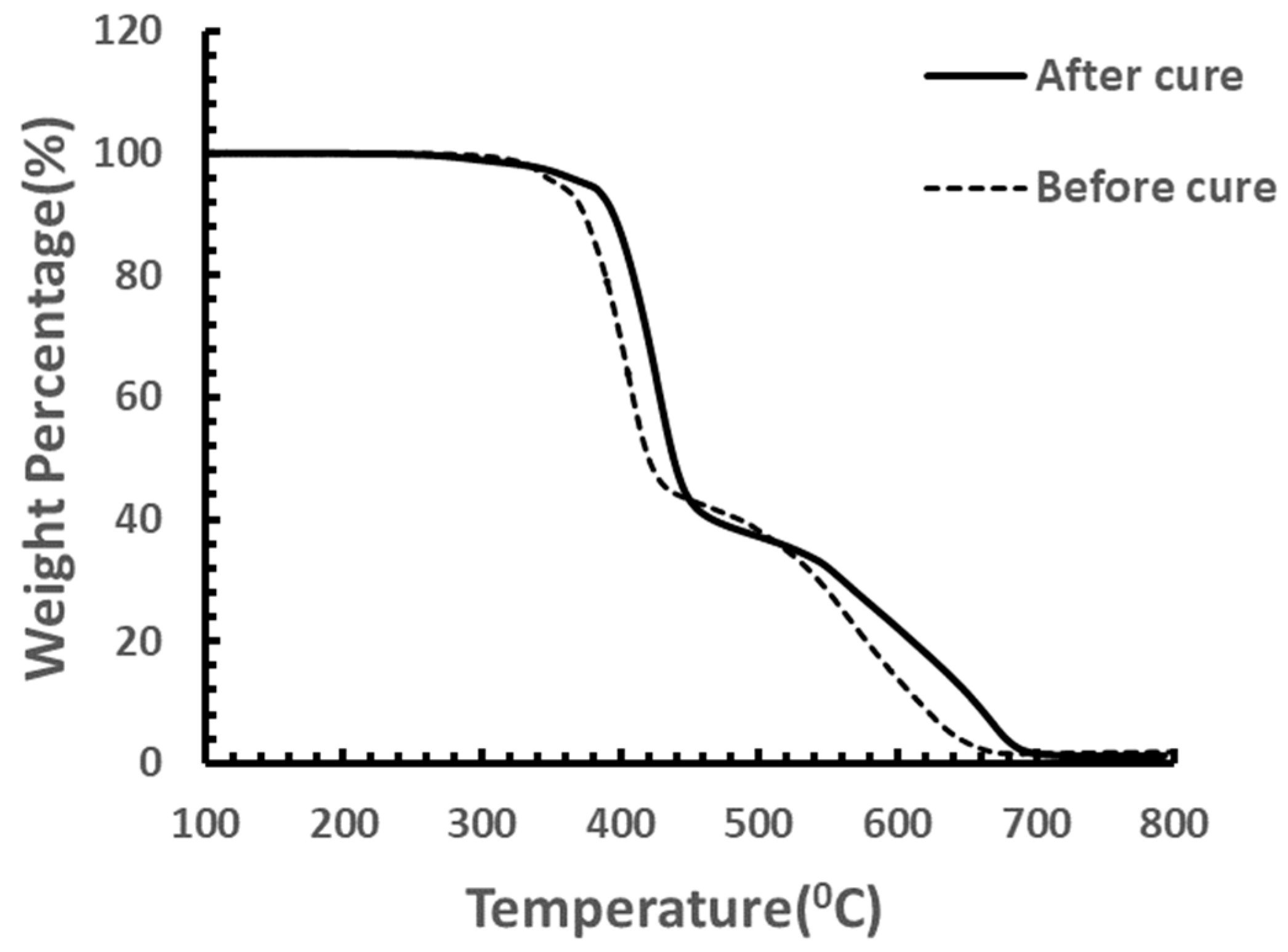1. Introduction
Epoxy is well known as one of the most important thermosets because of its versatility in physical and mechanical properties (Kern et al., 1994; Bratychak et al., 1999) [
1,
2]. Different combinations of epoxy pre-polymer and curatives can be formulated for specific mechanical property requirements. Usually, a high crosslinking degree is needed in cured epoxy systems to achieve desired properties, such as high heat deflection (i.e., high glass transition temperature) along with high stiffness and strength, excellent resistance to chemical corrosion, fatigue, and so on (Bilyeu et al., 1999) [
3]. The processing of epoxy is also simpler compared to other thermosets or thermoplastics because there are low shrinkage and the formation of almost no volatile by-products during the reaction. Due to the ease of application and excellent physical and mechanical properties, epoxies have been used in a wide range of applications, including coatings, protectants, adhesives, structural materials, electric encapsulates, and so on (Bilyeu et al., 1999) [
3].
Although highly crosslinked epoxy possesses lots of desirable mechanical properties, the inherent brittleness restricts its applications in structural materials, aerospace, sports goods, and automobiles. Therefore, many researchers have focused on the improvement of fracture toughness in epoxy systems. In general, there are two common ways: the first method includes changing the structure of epoxy chemically to modify the epoxy backbone from a rigid structure to a more flexible structure or decreasing the crosslink density either by increasing the pre-polymer molecular weight or by reducing the functionality of curatives. This method is highly technical and costly. The other more common method to improve the fracture toughness is the incorporation of a dispersed tougher phase in an epoxy matrix, which could be rubber (Kou et al., 2018) [
4] or thermoplastics (Velthem et al., 2016) [
5]. Although this approach can toughen epoxy efficiently, the inclusion of a softer phase causes a decrease in other mechanical properties like stiffness.
Recently, incorporation of solid fillers in the epoxy matrix has been becoming more popular compared to rubber toughening systems. Although this method provides lesser toughness compared to rubber toughening systems, the improvements in stiffness and modulus properties are significant. Such reinforcing elements can be fibers including glass fiber (Saravanakumar et al., 2020) [
6], carbon fiber (Feng et al., 2020) [
7], aramid fiber (Nasser et al., 2019) [
8], and boron fiber (Agrawal et al., 2020), [
9], which are usually used commercially in industry. They can also be fillers with different kinds of geometry, such as spherical, layered, tubular, or crystal structures, etc., which include silica (Picu et al., 2019) [
10], nanoclay (Chee et al., 2020) [
11], graphite (Joshi et al., 2020) [
12], cellulose (Nair et al., 2019) [
13], and carbon nanotubes (Singh et al., 2019) [
14]. Fiber-reinforced epoxies provide a better improvement in strength and fracture toughness compared to nanofiller-filled epoxies largely due to challenges in particle dispersion, tubes’ orientation, and interface bonding strength between the filler and the epoxy. However, recent studies have explored combining reinforcing fibers with nanoparticles in an epoxy matrix to address these limitations and further enhance performance, despite the low molecular weight of epoxy resin (Sergey et al., 2023) [
15]. Also, the easy processability, relatively low cost, and versatility successfully counteract their limitations and make such nanocomposites have broad applications in those fields which require less demanding mechanical properties, such as consumer goods, interior decoration in airplanes and automobiles, electrical conductivity, thermal conductivity, antistatic, EMI shielding, and so on (Pillai et al., 2011) [
16].
Carbon nanotubes (CNTs), formed by rolling single, double, or multiple layers of graphene onto themselves, have become very popular in composite-manufacturing industries due to their excellent mechanical properties (Young’s modulus > 1 TPa) (Lu, 1997) [
17], flexibility (Despres et al., 1995) [
18], tensile strength > 50 GPa (Iijima et al., 1996) [
19], high thermal and electrical conductivity (Dai et al., 1996; Ebbesen et al., 1996) [
20,
21], etc. CNTs have been used in a variety of matrices, which include polypropylene (Kumar et al., 2002) [
22], polycarbonate (Yoshino et al., 1999) [
23], polystyrene (Qian et al., 2000) [
24], poly (methyl methacrylate) (Jin et al., 2001) [
25], poly (ethylene glycol) (Jin et al., 2000) [
26], polyaniline (Cochet et al., 2001) [
27], poly (vinyl alcohol) (Shaffer and Windle, 1999) [
28], ceramics (Peigney et al., 2000) [
29], and metals (Kuzumaki et al., 1998) [
30]. A pronounced improvement of mechanical and electrical properties by the addition of CNTs has been reported (Sandler et al., 1999) [
31].
CNT-filled epoxy composites are fabricated on a lab scale mainly by mechanical mixing (Sandler et al., 1999) [
31], solution mixing (Zhu et al., 2003) [
32], CNT array (Wardle et al., 2008) [
33] buckypaper (Wang et al., 2003) [
34], and yarn (Zhang et al., 2004) [
35] impregnation methods. All these methods require low-molecular-weight epoxy resin and cannot produce highly concentrated CNT-filled epoxy. Resin transfer molding has been commercially used in industries to prepare CNT-filled epoxy composites (Cheng et al., 2009) [
36]. This method can produce highly concentrated CNT-filled epoxy composites with super-highly aligned CNTs though it is also limited to the use of low-molecular-weight epoxy resin. Low-molecular-weight epoxy combined with a high concentration of CNTs cannot provide good toughness. Therefore, it would be interesting to study the properties of highly concentrated CNT composites based on high-molecular-weight epoxy resin. However, due to the high molecular weight, this kind of epoxy resin is mostly solid at room temperature. This has made it impossible or much harder to process such high-molecular-weight epoxy using existing processing strategies. A high-temperature processing technique is required. On the other hand, an elevated processing temperature could easily accelerate the cure rate and possibly make the scorch time too short for most traditional high-temperature processing techniques, for example, injection molding. In this case, several factors need to be considered and kept in balance, for instance, high-temperature hardener selection, injection molding processing control, epoxy cure kinetics, final properties of the cured samples, and the economics of the whole strategy. However, as per the authors’ knowledge, up to now, there has been very limited work reported in this area, even though such composites can provide excellent mechanical properties with higher toughness as well as good electrical and thermal conductivities.
In this study, a traditional injection molding technique was used to process highly concentrated CNT (15 wt.%) composites based on moderately high-molecular-weight solid epoxy resin. A specific high-temperature hardener, hexahydrophthalic anhydride (HHPA), was selected. Based on the curing behavior of the combination of the selected hardener and epoxy, injection molding parameters were optimized. After molding, post-curing was also studied, and the post-curing conditions were finally optimized. The final product had excellent mechanical properties as well as high electrical conductivity.
4. Conclusions
In this study, a manufacturing technique was developed specifically for composites based on high-molecular-weight epoxy reinforced with a very high loading of CNTs (15 wt.%). Unlike traditional manufacturing methods for epoxy composite, in which molding and curing are combined in one process, our method was based on separate molding and curing conditions. Traditional injection molding with a cold mold was used to obtain perfect parts with the desired shape. Then curing of these molded samples was initiated and finished in the oven. This design can make molding and curing work separate and independent, which can dramatically increase the production rate without sacrificing parts’ quality. Intensive study on both injection molding processing and curing conditions was carried out. The processing parameters for injection molding were also optimized. Also, to obtain an in-depth understanding of the epoxy curing behavior, rheological properties of the cure system were studied in different conditions by a parallel plate rheometer. Both thermodynamic and kinetic behaviors were investigated, which eventually helped to find out the appropriate cure conditions for our samples. Results from mechanical, thermal, and electrical properties testing showed that our technique was able to make parts with excellent mechanical properties like high strength, toughness, and thermal stability as well as high and anisotropic electrical conductivity. Our method was proven to be an efficient, low-cost, high-volume production, and environmentally friendly way to manufacture composites based on high-molecular-weight epoxy reinforced with a very high loading of CNTs (15 wt.%).
The study successfully demonstrated an innovative approach to manufacturing high-molecular-weight CNT-filled epoxy composites, which yielded materials with superior mechanical, thermal, and electrical properties. Key takeaways from the study include the optimized processing methodology in controlling dispersion and curing processes, the superior performance metrics seen in the improved thermal stability, electrical conductivity, and mechanical strength compared to conventional epoxy systems, and the industrial potential to satisfy the demand for durable materials in aerospace, automotive, and electronic applications.
5. Challenges and Future Prospects of Work
The primary challenges associated with this work include achieving improved interfacial adhesion between the CNT fibers and the epoxy matrix, as well as attaining a uniform dispersion of CNTs within the matrix. Scalability may also pose a significant hurdle, especially for industrial applications. Furthermore, precise control of curing conditions and alignment of CNT fibers could introduce additional processing complexities.
Despite these challenges, the work offers promising future prospects. Advanced functionalization techniques can be explored to improve the compatibility of CNTs with the epoxy matrix, thereby enhancing interfacial properties. The integration of hybrid fillers, combining CNTs with other materials, presents an opportunity to develop multifunctional composites. Additionally, automation and process optimization hold great potential for ensuring uniformity and maintaining the quality of composites during large-scale production.
This research also highlights opportunities for expanded applications in emerging fields, such as renewable energy systems and high-performance structural components. Furthermore, the incorporation of sustainable practices, including the use of bio-based materials, aligns with global environmental goals, making this work a critical step towards the development of sustainable advanced composites.

